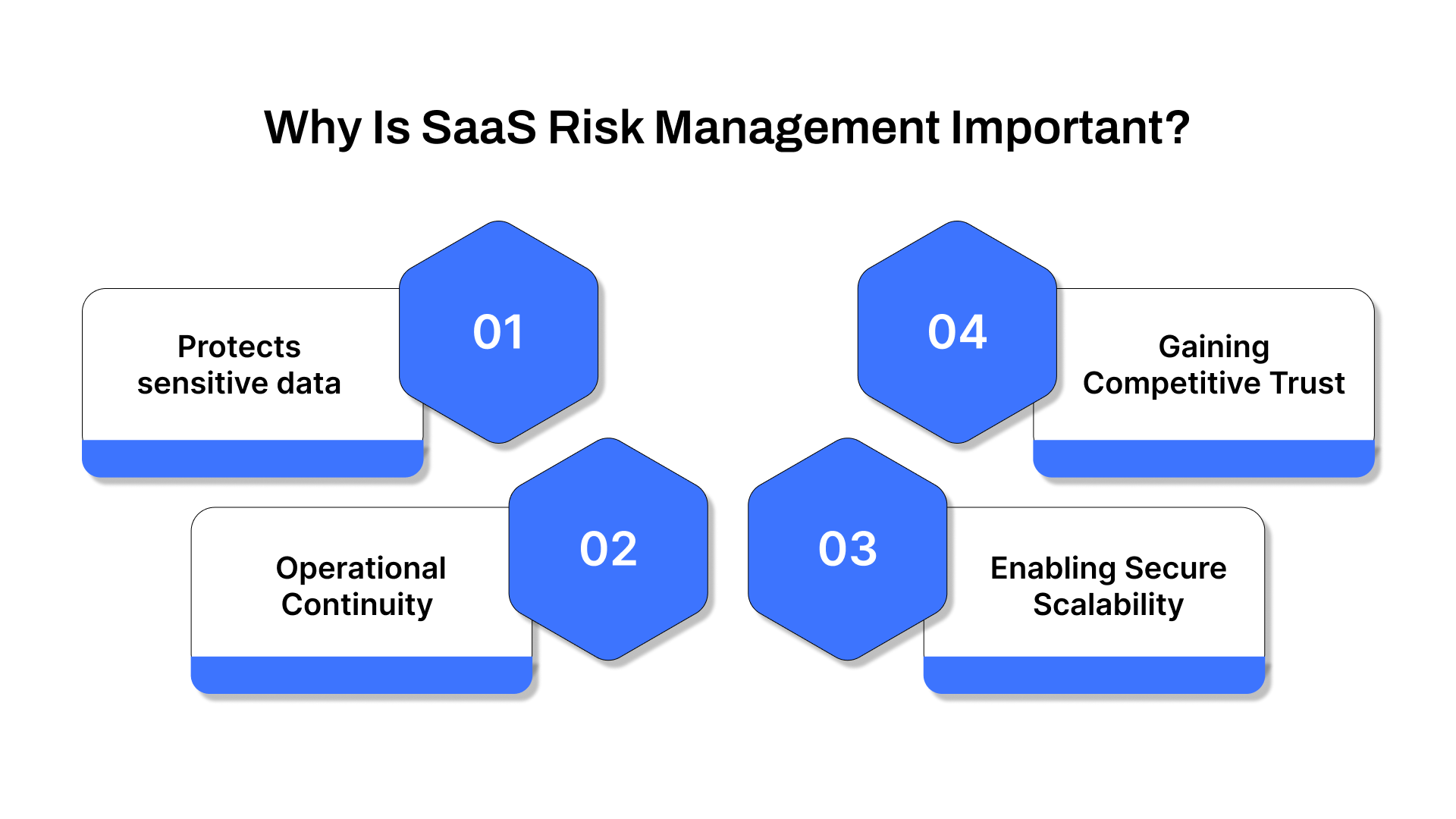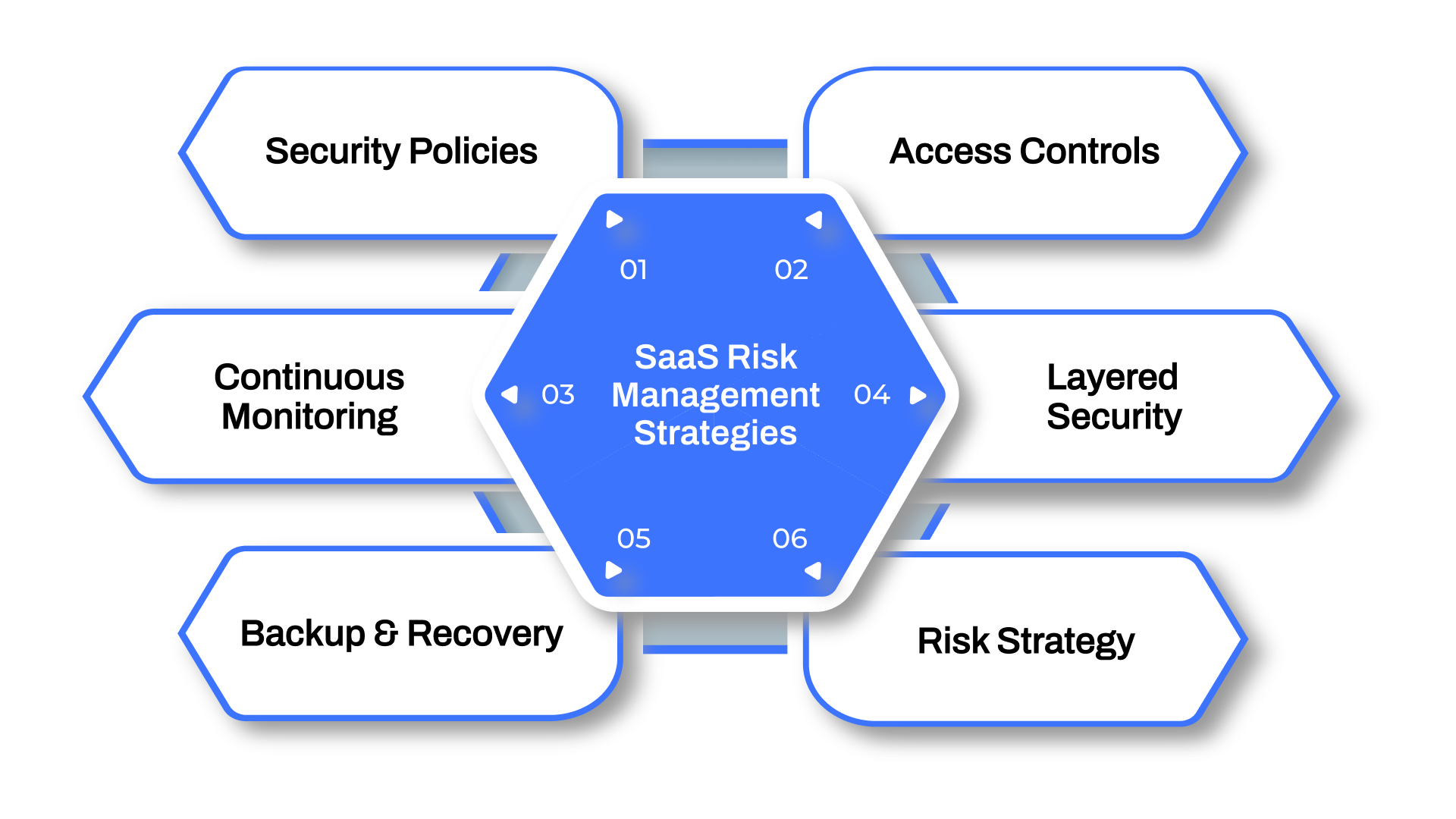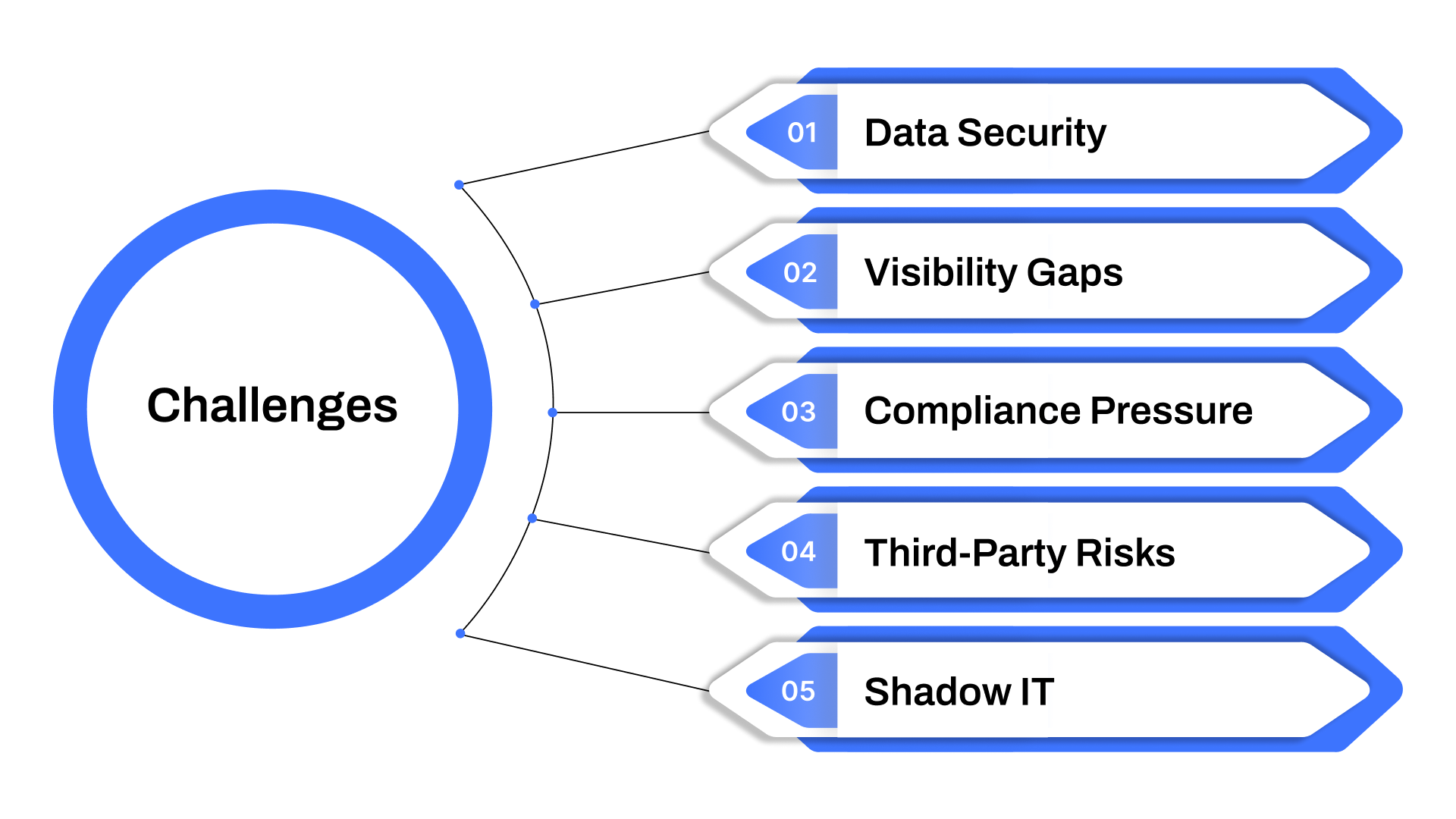Understanding SaaS Risk Management Strategies for Success
SaaS adoption is booming, and so is the risk that comes with it. Every new app, integration, or vendor expands your threat surface, creating potential vulnerabilities in security, compliance, and business continuity.
Yet many organizations still rely on outdated, fragmented frameworks that can’t keep up with the dynamic SaaS ecosystem.
SaaS risk management isn’t just about securing software; it’s about protecting your operations, customer trust, and bottom line.
This blog will explore what SaaS risk management really involves, why it matters, key risk types to watch, and how to build a future-ready strategy powered by Auditive’s continuous and contextual approach.
TL;DR
SaaS risk management protects sensitive data, ensures operational continuity, and supports secure scaling.
Key risks include shadow IT, data loss, misconfigurations, and unauthorized access.
Effective strategies involve robust policies, access control, regular monitoring, MFA/SSO, and incident recovery plans.
Continuous evaluation and AI-driven tools enhance responsiveness to evolving threats.
Auditive simplifies SaaS risk by offering continuous vendor monitoring, industry-specific compliance evaluations, and faster onboarding, all from a unified Trust Center.
What is SaaS risk management?
SaaS risk management is the structured approach to identifying, assessing, and mitigating the risks that arise from using Software-as-a-Service applications across the organization. But it goes far beyond simply cataloging potential threats.
A mature SaaS risk management program takes a deep, contextual look at each SaaS platform, from its security posture and data access policies to the vendor’s long-term viability and commitment to compliance. It involves continuously evaluating not only how secure an application is today, but whether the provider is equipped to respond to evolving threats tomorrow.
At its core, SaaS risk management is about operational resilience. This means applying mitigation strategies that are tailored and proactive, such as enforcing strong encryption standards, implementing strict access controls, conducting regular vendor audits, and fostering company-wide cybersecurity awareness.
The goal isn’t just to reduce risk, it’s to build confidence in your SaaS ecosystem while supporting business agility and innovation.
Why is SaaS risk management important?
SaaS tools are now embedded into every layer of modern business, powering everything from CRM and finance to HR and product development. But with that convenience comes exposure. Without a proactive approach to SaaS risk management, organizations risk losing control over their most critical assets: data, operations, and trust.
Here’s why it matters:
1. Protecting sensitive data
SaaS platforms often hold your most sensitive business and customer information. Without strong controls, data becomes vulnerable to breaches, leaks, or unauthorized access, especially when third-party integrations are involved.
A robust risk management framework ensures data integrity, confidentiality, and regulatory compliance.
2. Ensuring Operational Continuity
Downtime in a single SaaS tool can cascade across departments. Whether it’s a payroll platform going offline or a compromised collaboration suite, the business impact can be immediate.
SaaS risk management helps maintain continuity by identifying single points of failure and mitigating risks before they become outages.
3. Enabling Secure Scalability
As companies scale, their SaaS stack grows with them. But growth without control invites chaos.
With the right risk controls in place, organizations can adopt new tools confidently, knowing that governance, compliance, and security will scale alongside.
4. Gaining Competitive Trust
Demonstrating strong SaaS governance signals maturity to customers, partners, and regulators.
It builds credibility, boosts stakeholder confidence, and differentiates you in markets where security and compliance are non-negotiable.
Effective SaaS risk management isn’t just about risk reduction, it’s about unlocking secure, scalable growth with full visibility and control.
Top 6 SaaS Risk Management Strategies for Success
Effectively managing SaaS risk isn’t a one-time setup; it requires a proactive, evolving approach that aligns security, compliance, and operational performance. Below are industry-proven best practices to reduce vulnerabilities and enhance control across your SaaS ecosystem:
1. Establish Comprehensive Information Security Policies
Strong SaaS risk management starts with clear, enforceable policies that define how cloud applications are selected, deployed, used, and offboarded.
Your information security policies should cover:
Authentication protocols (e.g., MFA, password hygiene)
Vendor evaluation and onboarding processes
Encryption and data protection standards
Security patching and incident response
These policies serve as the blueprint for managing SaaS across its lifecycle, from procurement through decommissioning, and ensure security isn't an afterthought but a foundational design element.
2. Enforce Asset Management and Access Controls
In a SaaS-driven organization, every data asset and user entry point must be visible and governed. Begin by mapping all applications in use, understanding what data they access, and assigning ownership.
Then, implement access control policies that include:
Role-based access controls (RBAC)
Least privilege enforcement
Regular access reviews
Secure deprovisioning of users
This helps ensure sensitive data is only accessible to the right people, at the right time, under the right conditions.
3. Monitor and Audit SaaS Environments Continuously
SaaS risk doesn’t wait, neither should your response. Continuous monitoring helps identify abnormal activity, usage spikes, and potential breaches in real time.
Best practices include:
Deploying automated monitoring tools for visibility across all apps
Conducting regular security audits and configuration reviews
Tracking login patterns, permission changes, and external sharing behaviour
Combined with audit trails, this approach creates accountability and rapid incident response capability.
4. Implement Multi-Layered Security Controls (MFA + SSO)
Authentication is one of the most common SaaS attack surfaces, and one of the easiest to strengthen with layered controls.
Multi-Factor Authentication (MFA):
Requires users to verify identity through two or more factors (e.g., password + mobile prompt or biometric)
Dramatically reduces risks from credential stuffing or phishing attacks
Single Sign-On (SSO):
Centralizes access management and reduces password fatigue
Improves user experience while tightening control over session authentication
Together, MFA and SSO create a stronger, more manageable identity perimeter across your entire SaaS stack.
5. Integrate Backup and Recovery into Your Incident Response Plan
Even the best defenses can be breached. That’s why your SaaS risk strategy should always include backup and recovery protocols that ensure business continuity.
Key considerations:
Use cloud-native backup solutions that automatically capture SaaS data
Partner with vendors who offer versioning, restore points, and recovery SLAs
Test your restoration process regularly to validate speed and reliability
Backup isn't just for after a breach, it’s a strategic enabler of operational resilience.
6. Continually Evaluate and Evolve Your Risk Strategy
The SaaS landscape changes fast, so must your approach to managing risk. Static policies and one-time risk assessments are no longer sufficient.
Build a risk program that:
Uses real-time analytics to assess emerging threats
Utilizes AI-driven insights for anomaly detection and prioritization.
Updates frameworks based on shifts in regulation, vendor posture, and internal usage patterns
Modern SaaS risk management platform, like Auditive, help automate this process, ensuring your strategy evolves as fast as your stack does.
4 Types of Risks in SaaS
SaaS platforms are a double-edged sword. On one side, they offer speed, flexibility, and scalability. On the other, they introduce new layers of complexity and risk, particularly when security and governance don’t keep up with adoption. Understanding these risk types is the first step in managing them effectively.
1. Shadow IT
Not every SaaS tool in use across your organization is known to IT. In fact, many aren’t. Employees often onboard new tools without formal approval, a practice known as shadow IT.
While it may seem harmless, shadow IT creates massive blind spots in your security posture:
Data flowing into unvetted tools
Unmanaged user access
No oversight or incident response plans
If your risk team can’t see it, they can’t secure it.
2. Potential Data Loss
SaaS tools regularly access and store sensitive data, from customer PII to financials and trade secrets. Even with strong vendor contracts and privacy settings, breaches and leaks can still occur.
The risks include:
Violations of regulations like GDPR or CCPA
Reputational damage
Loss of customer trust
Effective SaaS risk management requires continuous monitoring of how data is accessed, shared, and stored across all applications.
3. Misconfigurations
The more SaaS tools you deploy, the harder it becomes to ensure every one of them is configured correctly. A single permissions misstep, like making internal data publicly accessible, can expose your business to unnecessary risk.
Common misconfiguration risks:
Overly broad file sharing settings
Weak access controls
Inconsistent security standards across teams
With over 300 SaaS apps in the average enterprise stack, automated visibility and auditing are essential.
4. Unauthorized Access
Former employees, contractors, or third-party partners often retain access to SaaS tools long after they leave. These dangling accounts present major security threats, especially if MFA isn’t enforced.
Additional access risks include:
Shared login credentials
Weak or reused passwords
Susceptibility to brute-force or phishing attacks
SaaS applications live in the cloud, but your perimeter still matters. Without centralized user lifecycle management, unauthorized access can quietly erode your defenses.
What Are the Challenges Associated With SaaS Risk Management?
Managing risk in SaaS environments isn’t just about plugging security gaps; it’s about navigating a complex web of decentralized systems, user behavior, third-party dependencies, and compliance obligations. Here are the key hurdles organizations face in building an effective SaaS risk management strategy:
1. Data Security and Privacy Complexities
With SaaS platforms handling sensitive customer and business data across cloud-hosted infrastructures, ensuring end-to-end data protection is no small feat. The biggest challenges here include:
Limited control over where and how data is stored
Gaps in encryption and access controls across platforms
Privacy regulation blind spots as data crosses borders
As data flows between tools, often via unsanctioned integrations, the risk of leaks and breaches grows. Continuous monitoring, robust governance, and data classification are crucial to stay compliant and secure.
2. Lack of Visibility and Control
The decentralized nature of SaaS means IT and security teams often don’t have a full inventory of what’s running in the environment, let alone who’s using what, and how.
This lack of visibility leads to:
Blind spots in security coverage
Inconsistent access control enforcement
Missed risk indicators and delayed responses
Without centralized oversight, you can’t protect what you can’t see. A strong risk posture starts with mapping your SaaS footprint and understanding its usage patterns.
3. Regulatory and Compliance Pressure
SaaS environments span multiple regions and legal jurisdictions, each with their own set of privacy and data protection laws (e.g., GDPR, HIPAA, CCPA).
The compliance challenges include:
Tracking where data resides and who has access
Aligning vendor contracts with regulatory expectations
Keeping up with constantly evolving legal standards
Falling short here can result in financial penalties, reputational damage, and stakeholder distrust.
4. Third-Party & API Dependencies
Most SaaS tools are built on or connected to external APIs, plugins, and microservices. While they improve functionality, they also expand your risk surface.
Challenges with third-party risk include:
Limited visibility into the vendor’s security posture
No standardization in how vendors report security controls
Difficulty enforcing internal policies across external systems
If one link in your vendor chain fails, it could compromise the entire system. This makes vendor vetting, onboarding, and continuous assessment non-negotiable.
5. The Persistent Risk of Shadow IT
Employees frequently deploy SaaS tools on their own, for convenience or productivity, without involving IT. This Shadow IT trend creates a parallel, unmonitored ecosystem that:
Circumvents formal security controls
Introduces unknown risks
Opens the door to unpatched vulnerabilities
Left unchecked, shadow IT erodes governance and weakens your risk posture.
SaaS ecosystems are dynamic and fast-moving, and the risks they introduce are just as fluid. Addressing these challenges requires a modern, unified risk strategy that includes discovery, automation, third-party vetting, and a security-first culture from the ground up.
How Auditive Helps Revolutionize SaaS Risk Management
Auditive centralises visibility, automates risk assessments, and customizes controls based on real business needs, all through one unified platform.
1. Unified Risk Dashboard
Monitor your entire vendor and SaaS ecosystem in a single, intuitive interface, no scattered spreadsheets.
“Most users can understand 80% of their risk exposure in seconds”
2. Continuous Third-Party Monitoring
Receive real-time alerts when vendor or SaaS security postures change, such as expired certificates, new vulnerabilities, or configuration drifts.
3. Vendor-Risk Evaluation with Context
Unlike generic scoring, Auditive lets you assess vendors against frameworks that matter for your industry, such as SOC 2, ISO 27001, GDPR, or financial regulations.
4. High Vendor Engagement Rates
Auditive’s Trust Pages streamline information sharing, boosting vendor engagement by an average of 35% faster response rates, accelerating risk review cycles.
Vendors respond 35% faster on average
5. Faster Onboarding, Seamless Integration
Tap into Auditive’s vendor network to onboard new SaaS providers 4× faster with pre-populated risk profiles and streamlined workflows.
Real-World Praise
“Auditive is changing the game from ‘vendor security reviews’ to ‘vendor relationships.’”, Christopher King, Analyst at Pelago, NextEra Energy.
“Auditive’s cutting‑edge AI technology enables us to review our vendors' security documents drastically faster.”, Andy Mahdavi, CTO at Doma
Conclusion
SaaS ecosystems move fast, and unmanaged risk moves faster. From misconfigured tools to overlooked third-party vulnerabilities, the potential for disruption is everywhere.
That’s why modern SaaS risk management needs more than a reactive stance. It needs a strong Vendor Risk Management (VRM) strategy, one that does more than just protect.
When you embed real-time oversight, customized vendor assessments, and automated risk workflows into your SaaS stack, you don’t just reduce exposure — you build operational trust, accelerate compliance, and enable secure growth.
A strong strategy isn’t just a safeguard, it’s a growth enabler. When you embed real-time oversight, tailored assessments, and automation into your SaaS workflows, you don’t just reduce exposure, you build operational trust.
Auditive’s Trust Center brings all this together. With continuous third-party monitoring, intelligent vendor scoring, and smooth workflow integration, your teams get the visibility and control they need to move with confidence.
Schedule a demo and discover how Auditive makes vendor risk management smarter, faster, and aligned with your business.
FAQs
Q1. What is SaaS risk management, and why does it matter?
A1. SaaS risk management refers to identifying, assessing, and mitigating risks associated with using Software-as-a-Service applications. It's crucial for protecting sensitive data, ensuring compliance, and maintaining operational efficiency.
Q2. What are the most common risks in SaaS environments?
A2. Common risks include shadow IT (unauthorized tools), data breaches, misconfigured permissions, and dangling access from former employees. Each of these can expose sensitive information or disrupt business continuity.
Q3. How can companies manage SaaS-related risks effectively?
A3. By implementing strong security policies, access controls, MFA/SSO, ongoing monitoring, regular audits, and robust backup/recovery systems. Continuous improvement of these practices is essential as threats evolve.
Q4. Why is vendor risk management important for SaaS applications?
A4. Since most SaaS apps are managed by external vendors, understanding and continuously monitoring their security posture is critical. A weak vendor can introduce vulnerabilities that affect your entire infrastructure.
Q5. How does Auditive help manage SaaS risk?
A5. Auditive offers real-time visibility, customizable vendor assessments, and seamless workflow integrations. Its Trust Center centralizes oversight, enabling businesses to onboard vendors 4x faster while maintaining high security and compliance standards.




